| Back |
The Carolinas Campaign
The Battle of Averasboro
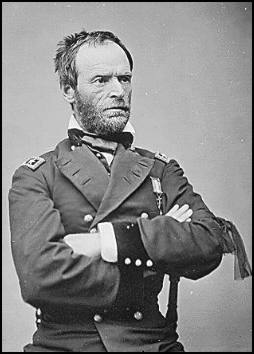 Sherman |
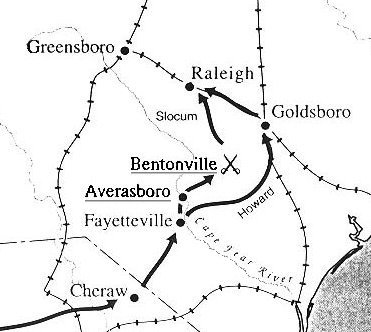 Sherman' March |
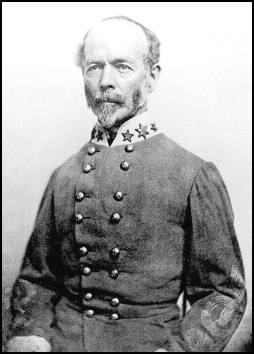 Johnston |
By March 8, 1865, the Federal army had crossed into North Carolina, en route to its ultimate destination of Goldsboro. At this important rail hub Sherman planned to unite with two other large Federal forces, under Alfred H. Terry and John M. Schofield, which would be moving inland from the coast of North Carolina. Sherman's grand "army group" was traveling as it had in Georgia, divided into two separate wings numbering nearly 30,000 men each. Having faced the wily Joe Johnston during the Atlanta Campaign, Sherman worried over his old adversary's return to command in North Carolina. But the Union commander was bent on occupying Goldsboro above all else, and he would become less wary as the march progressed.
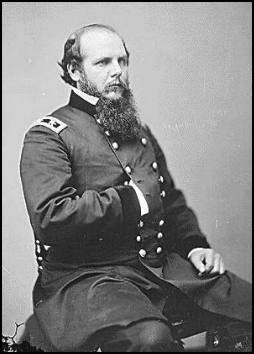
Schofield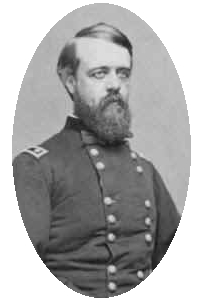
Terry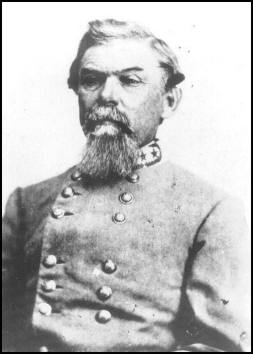
Hardee
Lieutenant General William J. Hardee, with a Confederate corps composed of garrison troops and seasoned combat veterans, had managed to stay one step ahead of the Federal advance in South Carolina. After evacuating Charleston and falling back before Sherman, Hardee reached Fayetteville, North Carolina on March 9. Joe Johnston was also there, but left that night for Raleigh to oversee the concentration of the Army of Tennessee which was then moving east by rail from Charlotte.
As the Federals slogged through the Carolina pine country, Judson Kilpatrick's cavalry division screened the advance of Sherman's Left Wing, commanded by Gen. Henry W. Slocum. At dawn on March 10, with his command divided and upon separate roads, Kilpatrick was surprised by a Rebel cavalry force under Lt. Gen. Wade Hampton. This small engagement at Monroe's Crossroads was the first organized assault on a portion of the Federal army in North Carolina. The affair was brief but bloody, and served to warn the careless Kilpatrick that Hampton's cavalry could not be trifled with. Confederate resistance would continue to stiffen as the Union horde pushed deeper into the Old North State.
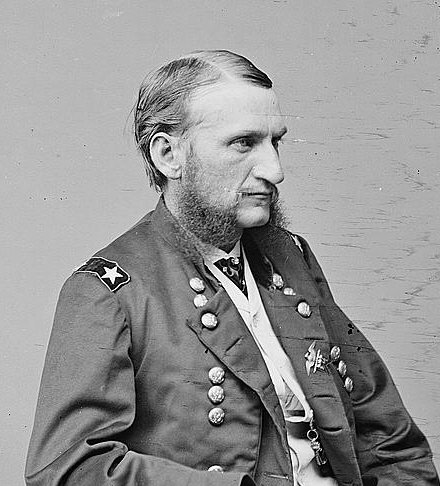
Kilpatrick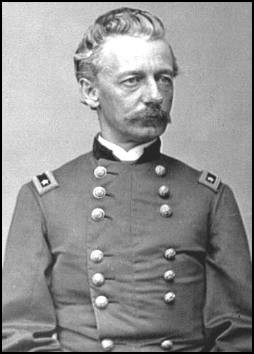
Slocum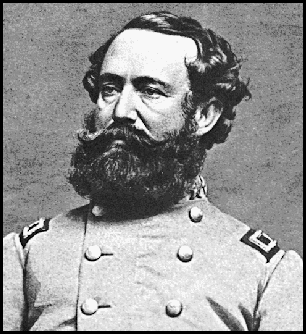
Hampton
As Sherman approached Fayetteville that same day, Hardee withdrew to the northeast on the Raleigh Plank Road, halting at the community of Smithville a few miles south of Averasboro. Johnston instructed Hardee to remain as close as possible to the Federal line of march. The Confederate commander was relying on Hardee and Hampton for information on the enemy's true destination, so that Johnston might combine other Confederate forces with them in an effort to stop Sherman.
The Federals reached Fayetteville on March 11, and occupied the town after a brief skirmish with elements of Hampton's cavalry. The Confederate troopers burned the bridge over the Cape Fear River and fell back to monitor the progress of the Union advance. On the following day the old U.S. arsenal at Fayetteville was destroyed to prevent its further use by the Confederates. The stopover at Fayetteville also afforded Sherman's army its first contact with the outside world since leaving Savannah. After communicating with General Terry, and receiving mail and limited supplies for the troops from Wilmington via the Cape Fear River, Sherman was on the move again by March 14. Though he was banking on entering Goldsboro without a fight, "Uncle Billy" boasted to U. S. Grant that "The enemy is superior to me in cavalry, but I can beat [Johnston's] infantry man for man, and I don't think he can bring 40,000 to battle. I will force him to guard Raleigh till I have interposed between it and Goldsborough." Sherman was hoping that Johnston would pull back to safeguard North Carolina's capital city, and thereby leave the way clear to Goldsboro.
"Unity of purpose and harmony of action between [our] two armies, with the blessing of God, I trust will relieve us from the difficulties that now beset us." -Robert E. Lee to Joseph E. Johnston, March 15, 1865.
On March 15, Robert E. Lee again expressed to Joe Johnston the critical military situation facing both commanders. Among other worries, the Confederate general-in-chief feared that if Sherman were to push Johnston out of eastern North Carolina--uncovering Raleigh and the important rail lines to Virginia--the beleaguered Army of Northern Virginia would suffer for want of supplies. Lee cautioned "Old Joe" to choose his opportunities wisely, "for a disaster to your army will not improve my condition," he explained, "[and] I would not recommend you to engage in a general battle without a reasonable prospect of success." Unable to send reinforcements to Johnston in North Carolina, Lee relied upon the general's ability to gather the widely scattered forces at his disposal and block Sherman's path northward. Placing a high degree of confidence in his old friend and subordinate, Lee urged that "an opportunity may occur for you and [Department of North Carolina commander Braxton] Bragg to unite upon one of [Sherman's] columns and crush it."
Johnston traveled from Raleigh to Smithfield that same day, where he began assembling the hodgepodge Army of the South from the four separate commands at his disposal: the remnants of the Army of Tennessee, Hardee's Corps, Gen. Robert F. Hoke's Division (nominally under Bragg), and Wade Hampton's cavalry. As Hampton later noted, "it would scarcely have been possible to disperse a force more effectually":
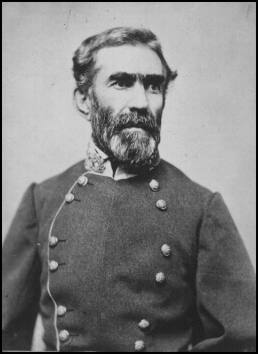 Bragg |
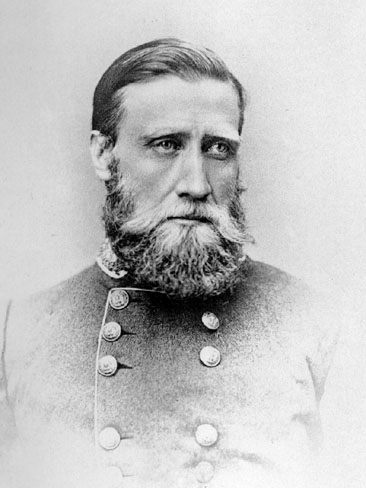 Hood |
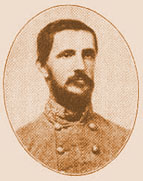 Hoke |
1) Braxton Bragg, after evacuating Wilmington and resisting Schofield's advance below Kinston March 8-10, was ordered by Johnston on March 13 to move from Goldsboro to Smithfield. Bragg arrived with Hoke's Division late on March 15. This veteran force from the Army of Northern Virginia had been sent south by Lee in December 1864, to help safeguard Fort Fisher and the port of Wilmington--the all-important hub of Lee's "lifeline" to Virginia via the Wilmington & Weldon Railroad.
2) The Army of Tennessee units were slowly trickling in from the west, having departed Tupelo, Miss., by rail in mid-January. This ill-fated force--the Confederacy's principal Western army--had been dashed to pieces three months earlier while under command of Gen. John Bell Hood in Tennessee. Following the Confederate disasters at Franklin and Nashville in November and December 1864, the remnants of the Army of Tennessee had fallen back into Mississippi.
3) Hardee's Corps, after retreating from Fayetteville, was bivouacked near Averasboro, along the route of march of the Federal Left Wing.
4) Wade Hampton's cavalry consisted of Wheeler's Corps of the Army of Tennessee, and Butler's Division from the Army of Northern Virginia. This force was split to monitor the advance of Sherman's divided army, with Butler shadowing Gen. O. O. Howard's Right Wing and Wheeler falling back before Gen. H. W. Slocum's Left Wing.
Joe Johnston was gathering an army, but the general knew he could not match Sherman numerically. Lacking sufficient numbers to oppose the combined Federal force, "Old Joe" would be forced to tackle one wing of Sherman's divided army while it was beyond supporting distance of the other. If Johnston could crush one wing, he might then fall upon the other with a greater chance of success. But would he be able to assemble a cohesive force in time to block Sherman's advance? As his scattered units converged, Johnston anxiously awaited news from Hardee and Hampton regarding the true destination of Sherman's grand army. General William J. Hardee would soon begin providing answers.
A Delaying Action at Averasboro....
"The lieutenant-general commanding thanks the officers and men of this command for their courage and conduct of yesterday, and congratulates them upon giving the enemy the first serious check he has received since leaving Atlanta. . . .by command of Lieutenant-General Hardee." --Lt. Col. Thomas B. Roy, AAG, staff of W. J. Hardee; General Orders No. 16, March 17, 1865
On March 15, at the community of Smithville (not to be confused with Smithfield) below Averasboro, General Hardee--with approximately 6,455 effectives--deployed his command in three lines in a well-chosen defensive position. Here the Cape Fear and Black Rivers were only about two miles apart, and Hardee's command spanned the distance between them, blocking the Federal Left Wing's advance on the Raleigh Plank Road. The first two lines constituted Gen. William B. Taliaferro's division of untried garrison troops: A. M. Rhett's Brigade in front, followed by Stephen Elliott's. Some 600 yards in rear of Elliott's line lay Hardee's more experienced command: the four brigades of combat veterans and one brigade of reserves constituting Gen. Lafayette McLaws's Division.
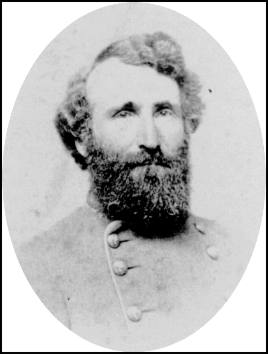 Taliaferro |
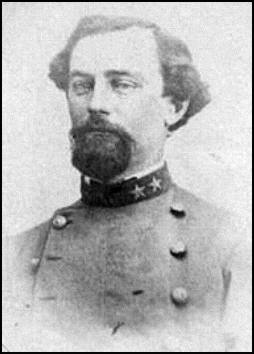 Elliot |
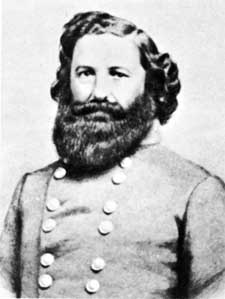 McLaws |
Behind Hardee's position between the rivers, the plank road continued north to Raleigh, while another road forked eastward toward Goldsboro. Joe Johnston was concerned over which route the Federal Left Wing would follow. Was it heading for Raleigh, or Goldsboro?
About 3 p.m. on March 15 the 9th Michigan Cavalry, followed by the rest of Smith D. Atkins' Federal horsemen, made contact with Taliaferro's skirmishers. Finding the road blocked, Atkins deployed astride the Raleigh Plank Road, and sharp skirmishing occurred throughout the afternoon. As night fell a heavy rain set in, and the aristocratic Col. Alfred M. Rhett, having been captured by a party of Federal scouts, was mortified to find himself a prisoner in the hands of Capt. Theo Northrop. By 12:30 a.m. on March 16, the first Union infantry reinforcements were arriving in the vicinity of Smithville. Colonel William Hawley's brigade of the XX Corps, departing Bluff Church, had marched a dismal five miles in a thunderstorm to relieve Atkins's troopers at the front.
At 2 a.m. William T. Sherman sent a note to Gen. A. H. Terry, whose Provisional Corps would soon be leaving Wilmington for the rendezvous at Goldsboro: "Thank you . . . for the certain knowledge that General Schofield is in possession of Kinston. That is of great importance, for thence to Goldsborough there are no bridges. I will, in consequence, move straight on Goldsborough . . . . Hardee is ahead of me and shows fight. I will go at him in the morning with four divisions and push him as far as Averasborough before turning [east] toward Bentonville and Cox's Bridge."
Several miles to the south, Gen. Oliver O. Howard's Right Wing was crossing South River (a lower extension of the Black), with Butler's Confederate cavalry closely monitoring its advance. Thus far Sherman was comfortable with the progress of the campaign, and he wanted nothing to disrupt his timetable for reaching Goldsboro. Worried that his divided forces might stray too far from one another, the Union commander warned Howard: "[A]ll is working well around us and we must not scatter, but aim to converge about Bentonville, and then Goldsborough." Counting on the weather to hinder Confederate operations, Sherman added: "The rain is as bad for our opponents as for us, and I doubt if they have as good supplies or transportation as we."
By 9 a.m. the Federals were preparing to brush Hardee's Corps out of the way. The XX Corps divisions of William Ward and Nathaniel Jackson joined Hawley's brigade at the front, Ward moving to the left while the remainder of Jackson's division joined on the right of Hawley's line. The Union battle line soon advanced to within 500 yards of Rhett's Confederate brigade, which was deployed astride the road just north of the John Smith house ("Oak Grove").
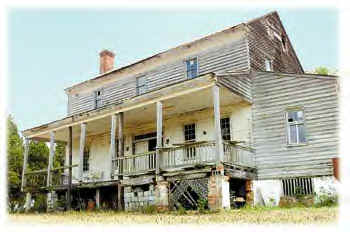 Built 1793 |
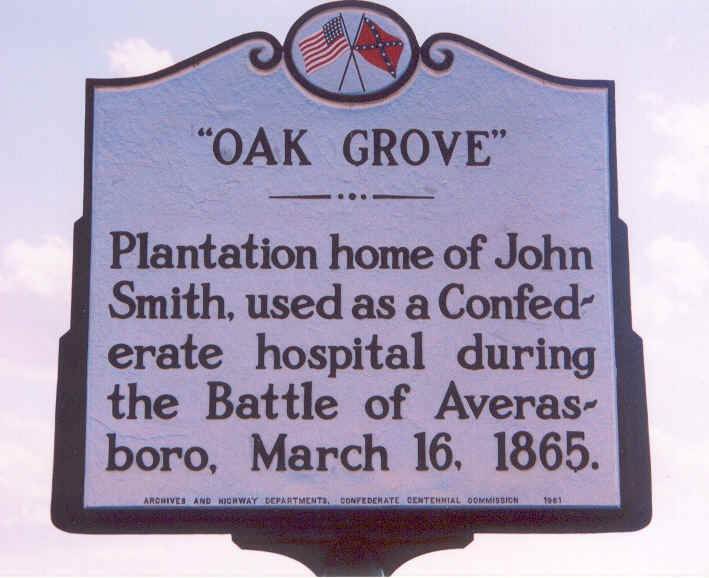 Historical Marker |
At 10:30 a.m. the engagement began in earnest when Gen. H. W. Slocum ordered Col. Henry Case's brigade to flank the Confederate line and clear the road. Moving well to the left, Case's men crossed a large ravine and attacked squarely upon the right flank of Rhett's Brigade. At the same time, Col. Daniel Dustin's brigade advanced in front. Though Rhett's men had stood well thus far in their first taste of combat, the Union assault was too great to bear and the Confederate line was sent reeling backward toward Elliott's position to the north. Three field pieces on Rhett's line were captured, and two of them were turned and fired at their former owners as they scampered toward the rear.
Around 1 p.m. the Federals advanced on Elliott's line, while Judson Kilpatrick's troopers attempted to flank the Confederate left. Kilpatrick's maneuver was thwarted, however, by the 32nd Georgia and 1st Georgia Regulars, which had been sent forward from McLaws's line in an effort to stem the Federal advance. The 2nd South Carolina (Conner's Brigade) was also sent forward to anchor Elliott's right flank, but the Union infantry advance was too great to withstand. Taliaferro's second line crumbled, and retreated toward the relative safety of McLaws's position.
As Hardee had planned, his inexperienced units had opened the battle and were falling back toward his main defensive position. "Old Reliable" lengthened his third line by deploying Elliott in the center, with three of McLaws's brigades to his left and one to his right. The timely arrival of two divisions of Gen. Joseph Wheeler's cavalry prolonged Hardee's line westward to the bluffs overlooking the Cape Fear River. Having borne the brunt of the battle thus far, Rhett's Brigade was drawn up in reserve behind the main line.
As the afternoon wore on Gen. James D. Morgan's Federal XIV Corps division moved in on the left of the XX Corps. Skirmishing remained sharp, with the opposing lines in close proximity, but the Federal advance stopped at Hardee's third line. The day's light rain had given way to a downpour in the afternoon, worsening the muddy terrain and hampering troop deployment. Having been delayed by muddy roads rendered nearly impassable by the recent rains, Carlin's XIV Corps division arrived around dusk and formed in reserve of the main Federal line. Sherman then postponed any further attack until the next morning.
Late in the afternoon General Hardee sent word to Joe Johnston that he had checked Sherman's advance, and that he would retire toward Smithfield after dark. At nightfall the Confederate artillery pulled out, followed around 8:00 p.m. by the infantry (which had built campfires to help disguise the retreat).
The engagement at Averasboro cost Hardee's Corps about 500 casualties. Slocum's Federal Left Wing lost 682, bringing the total to approximately 1,182. Sherman considered his casualties at Averasboro "a serious loss," as the wounded further encumbered the Union wagon trains, which were toiling over muddy and difficult roads.
 A William Waud sketch of action at Averasboro, N.C. March 16, 1865 |
HOME
About SCV -
Join SCV -
Legionary -
Co. News -
Member Services -
Education
B.F.C. -
Ancestors -
Memorials -
Links -
Photo Gallery -
Guest Book -
Site Index